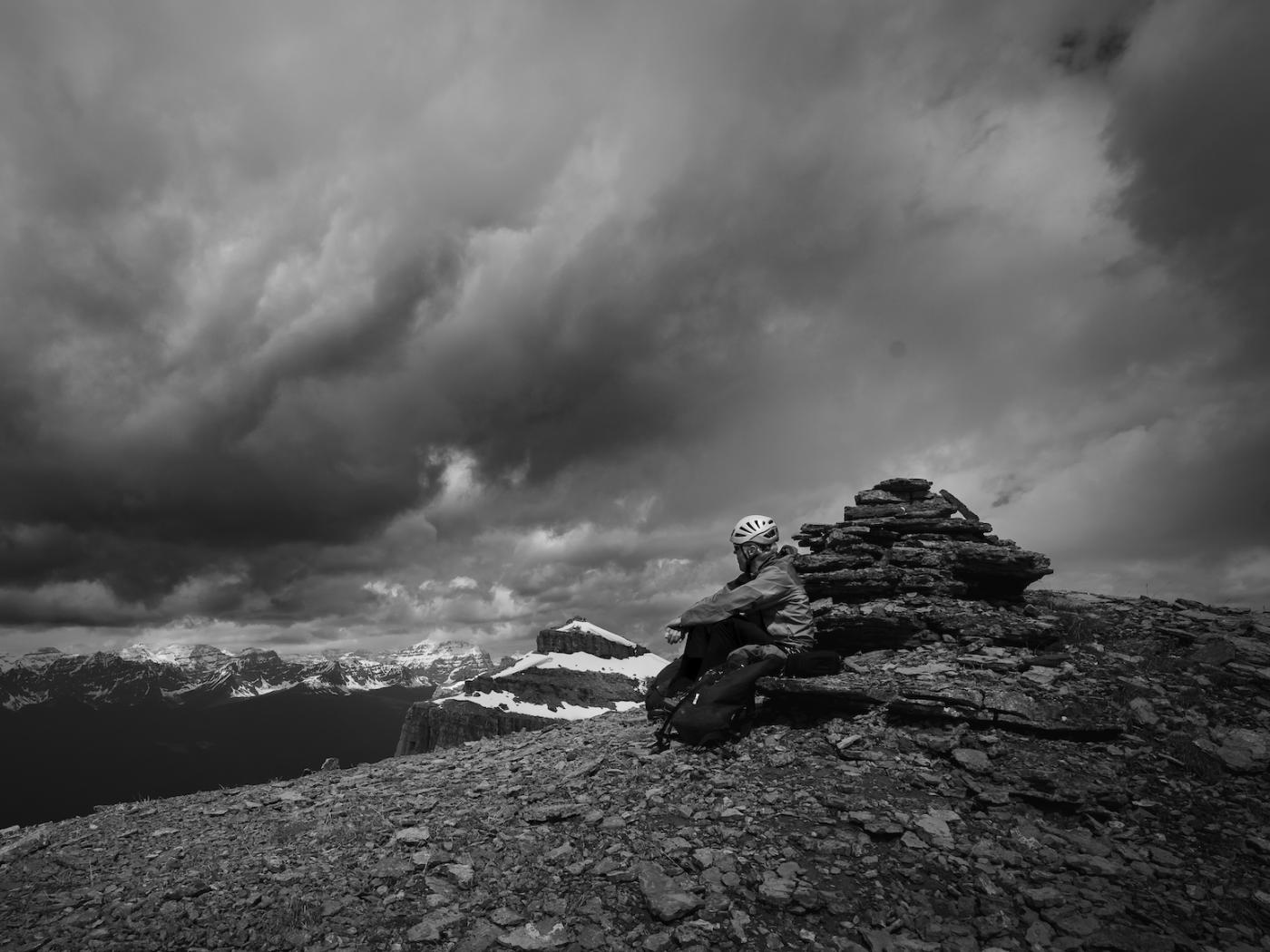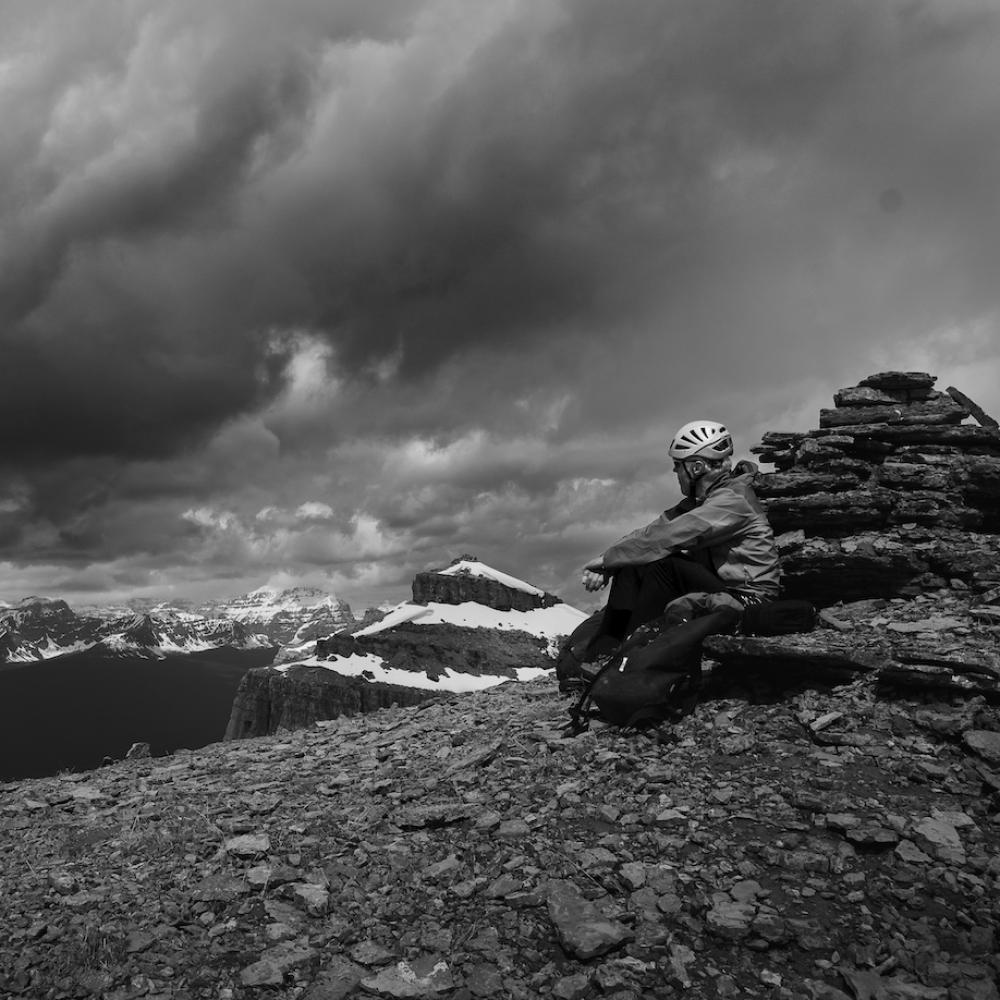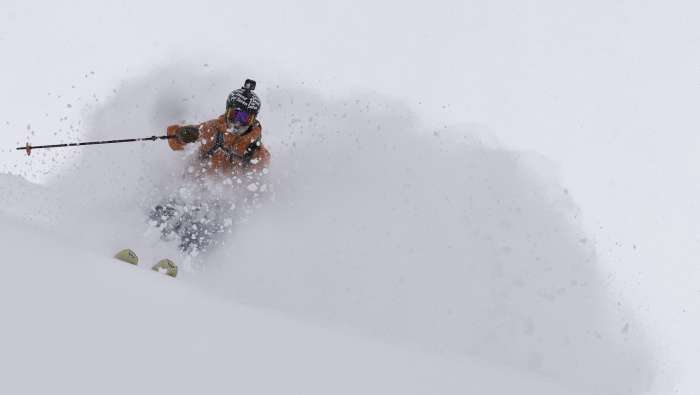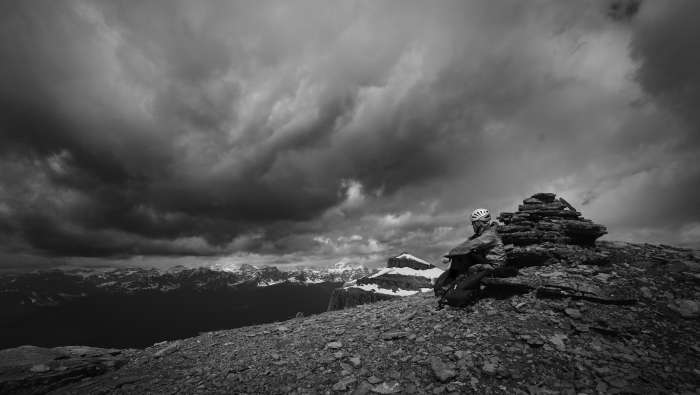Climbing Castle Mountain - Eisenhower Tower Alpine Rock Ascents


Castle Mountain - An Alpine Rock Classic Ascent in Banff National Park.
Eisenhower Tower is a route we see a lot of each summer season, and for good reason. Winter snows will usually recede enough by June that dry, summer ascents come into swing and we're often up and down this peak a number of times every month through to late September on a combination of both Privately Guided Ascents as well as with the students on our Beginner Mountaineering Courses each season.
Given its position above the Trans-Canada Highway here in Banff National Park, you can't help after climbing it but remembering back to what it took to work through each of its complexities. The lower tier to the Goat Plateau, the up down and around it takes to get through the Dragon's back, crossing the snow patch, and the final pitches through a break in the summit line which yield in a split second, 360˚ views of the Bow Valley 4000ft+ below your feet. It's a route that even after the challenges and work of the day are long gone, you'll look up each time you pass it by on the highway below and it brings back memories like it was yesterday.
July 2nd was the first trip of the season for us. A little later than usual, but with consideration to COVID primarily, and a deeper than average winter leaving much of the alpine a little late to come into shape, we'll take it. A beautiful day to be up high.
Trip & Conditions Report July 3rd, 2020:
Weather this week has been a mixed bag, with colder temperatures and precip on and off here this week, a variety of higher elevation locations in the neighborhood saw up to 10cm's of new snow earlier this week. Despite that, much of the route up the Eisenhower Tower dried up quickly and was in great shape. We followed the usual approach via the Rockbound Lake trailhead which at present, it's worth remembering at present this parking lot is closed to vehicles as the HWY 1A is closed at the junction with 93N. Parking is limited to 30min at the Castle Mountain Chalets, but there are a few options nearby where you can park longer term in Parks Canada lots. The trail headed up from the parking lot to the point where you turn the ridge and head back towards Rockbound lake is mostly dry, with a few swampy sections but as you turn the ridge the trail begins to hold more water which can be a bit challenging to work around. Worth remembering, it's better to get your boots a little dirty than to wander too far off the trial, encouraging others to further widen the braiding occurring in the trail here.
The ascent through the lower tier of the mountain, below the Goat Plateau, was dry and easy going despite the previous few days precip. The Dragon's Back was much the same, dry and generally consistent with mid-summer conditions. The ditch at the end of the Dragon's Back, immediately before you arrive at the base of the Eisenhower Tower proper is holding a bit of snow, and the access into it a bit damp, but again, travel was pretty darn cruisy.
On the upper tower, there is still a substantial amount of snow above the gully where one would choose either the Left and Right variations above. Most years we've found this chunk of snow can be a bit of an advantage for your ascent; it helps to keep the large volumes of rock and scree below from moving (reduces rockfall), and also as it melt out gives climbers the option of refilling water bottles mid route so you can keep the weight down in your packs. It can also be used on the descent as it increases the speed in which a party can descend if the snow is still extending down to the bottom of the scree bowl. It will save you a rappel at least and generally speeds things up as you're not forced to descend the more awkward prow or ridge feature on climbers left one normally might once the snow patch has melted out.
Lots of opportunity to refill water bottle both on the approach as well as on route. If you're leaving the parking lot in the morning with a liter... you're probably carrying more than you'll need ;)
What Goes Into Our Guided Ascents?:
Booking an ascent with our Guides starts with dropping us a line to get a conversation started. Usually we like to get a sense of whether the objective will be a good fit given your background and experience. While the route is graded 5.5, generally considered quite manageable, the is no question it's a big day in the hills and we want to make sure we're setting your team up for success. In the weeks leading up to your ascent, we're watching weather and conditions evolve and once we're inside the 7-day mark, we begin to firm up final plans and logistics for your day. Guests who have booked a program with us will receive a final logistics package via email a week in advance of their booked trip where we review essential equipment, and get our heads wrapped around the weather and conditions likely to show up for you on your ascent. T-48hrs... we touch base again, and the final go or no-go call is made based on weather models and conditions at that time.
On the morning of your ascent, we meet early. Our aim is to be the first in line on the ascent so as not to be exposed to other parties and potential rockfall issues. Further, in being mindful of the risk of viral transmission posed by COVID-19, we don't want to be in a position en route where we run into other parties or traffic jams. Ensuring we're first in line gives us mobility, the option to escape pinch points easily, and to ensure that issues like rockfall can be well managed. That said, we'll be meeting in the parking lot, at the trailhead between 4-5am Not completely uncivilized, but close, depending on your perspective!
After a quick gear and essentials check, review of expected weather and conditions, we'll have you review and sign our waiver (recently updated), and we'll be off. We break the approach down into a few sections. Along the Rockbound Lake trail, a spring crosses it about 5km from the trailhead. We generally will break for 10-15min. here to grab a bite to eat and refill water bottles. From here we leave the Parks Canada trail exiting onto the climber’s approach trail and follow this for another 30min or so to the base of the lower tier of the mountain. Another short break here to eat, drink and get ourselves into harnesses and onto the rope and we're off and moving again for the next leg, ascending through the lower tier, to the Goat Plateau. This section despite how intimidating it looks standing directly below it, actually climbs a series of ledges and weaknesses in the wall that often have our Guests commenting in tune with "that was a lot easier than I was expecting". In reality the lower tier often breezes by given your Guides knowledge of the weaknesses and subtleties on the route, and 20min or so later you'll be standing on the Goat Plateau, on your way across to the base of Eisenhower Tower.
To access the main body of the Eisenhower Tower, we leave the Goat Plateau and ascend/cross a feature known as the Dragon's Back. This is usually climbed using a combination of short-roping techniques interspersed with a handful of short pitches up to 5.4. Arriving at the base of the main tower, we cast off into 3-4 steeper pitches which climb up to 5.5 that takes us to the junction between the left and right variations to the summit. More often than not we cross below the snow patch to gain access to the left variation and ascend to the summit through easy fifth class pitches and fourth-class steps. All goes well, with a 5am departure, we're typically standing on the summit between 10-11am.
To descend, we reverse the route through a series of rappels and short-roped 4th class sections back to the Goat Plateau. We get packed up on the Plateau and again make a quick short-roped descent back down through the lower tier, and all that's left afterward is the walk back to the trailhead. The descent on the trail systems will take about 1.5hrs to wrap up the day. Total descent time from summit back to trailhead on average will take about 4hrs. A total round-trip time of about 8-10hrs is fairly standard fare.
So, what are the advantages of hiring a Mountain Guide for an ascent like this? Do I really need one? It all depends on what kind of experience you're looking for, where your skill set lie, and in what kind of style you would like to complete the ascent. Routes like this require extensive route-finding ability, and without a doubt are where our Guides will bring value. While finding the base of the route from the Rockbound Lake Trail is generally straightforward, once you've roped up at the bottom of the lower tier, the route finding becomes more challenging. Beginning from the bottom of the lower tier, knowing which of the many short steps to wander up, which weakness to follow, or which gullies to stay away from to maintain efficiency, and reduce rockfall potential are all rationale to have one of our Mountain Guides along for an ascent with you. On a long Alpine Rock Route such as Eisenhower Tower, there is also a never-ending series of transitions in protection systems based on the changing nature of the terrain. This is another area where our Guides will bring value. Given that the route is a constantly changing mixture, of 5th class climbing, easier 4th class scrambling sections, and easy walking in between, moving seamlessly during the endless transitions is a key to speed and efficiency on your ascent. By using a mixture of pitched climbing techniques, short pitches, and short-roping techniques, and use of terrain for belays (instead of gear or hardware) generally we're able to maintain very comfortable levels of protection for our Guests without compromising efficiency.
Want more information on our trip options and details?
CLICK HERE to Learn more about our Guided Ascents, including trip itinerary, logistics, and pricing. This ascent can be booked with a variety of our Guides, meaning flexible pricing options depending on your preference.
Or drop the office an email at guest.exp@cloudnineguides.com or call +01-403-707-5877
Non-Guided Ascents? Some thoughts and ideas on how to prepare:
If you're looking at Eisenhower Tower as one of your first Alpine Rock Climbs, non-guided, the following might help inspire some ideas on whether you're ready to roll:
- Consider your ability to recognize and anticipate transitions in both the terrain and where protections systems are required?
- Have I got a good shortlist of routes on the resume, that have challenging route finding? Either Scrambles or other shorter moderate Alpine Rock Climbs?
- Am I comfortable with longer run-outs in easier low-end 5th class terrain?
- Can I generally manage rock-fall hazard where higher potential for it exists?
- Am I generally completing other Alpine Routes in the times suggested in guidebooks, trip reports, this blog etc.
And a few suggestions to stack the odds of success in your favor:
- Wait for a perfect weather forecast. This route is climbable in less than ideal weather, but things get hectic quickly when there's verglas, snow or wet terrain to move through. Extended periods with stable conditions are best.
- Check out our
RESOURCESPage for our favorite Weather Products and Apps. - How many hours of daylight do I have to work with? Pick a longer day of the year, close to the summer solstice to buy your self a bit of a buffer if the ascent is slower than expected.
- What if things go wrong? Do I have a first-aid kit and skills to use it? Am I carrying emergency communication equipment (2 independant units is best).
- Check out our
Emergency Contact List - Choose the right partner.
- Bring only what you need, and keep your pack light.
What our Guides (typically) carry on ascents:
- 2 Anchor Kits - 120cm sling + 2 non locking carabiners
- 4 Locking Carabiners
- 2 x 240cm slings (in place of prussik or accessory cord)
- Personal Prussik @ 1.2m
- Micro Traxion
- 3 Cams - Black Diamond Ultralight Camalots Gold/Red/Green
- 3 Quickdraws
- Black Diamond Guide ATC.
- First Aid Kit
- Emergency Bivi Tarp
- Emergency Communications. VHF/UHF Radio and Cell Phone
- Harness
- Helmet
- 50m 8.9mm Single Rope. (You can get away with a 40m 8.9mm if you're comfortable with belayed downclimbing in places, and can make use of the snow patch on descent to skip some of the longer rappelling sections.
- Ice Ax (if the snow patch is still present)
- 28L Backpack
- Good Vibes
Check out these other Resources to aid in your pre-trip planning:
- Summit Post
- Mountain Project
- Guidebook: Rockies Central: David P. Jones.
Inspired? Hope so! Give it a try - It's one of the classic ascents in the Canadian Rockies and a feather in the helmet of any seasoned or aspiring alpinist. To pick up any gear and equipment listed above, check out our local gear and equipment shops in the Bow Valley, Banff and Canmore for a great selection of Black Diamond Equipment and other essentials, and feel free to reach out with any questions for either Guided or Non-Guided ascents, or how we're managing these program during the time of COVID-19.
Happy Climbing!
The Cloud Nine Guides.
MORE FROM OUR BLOG


